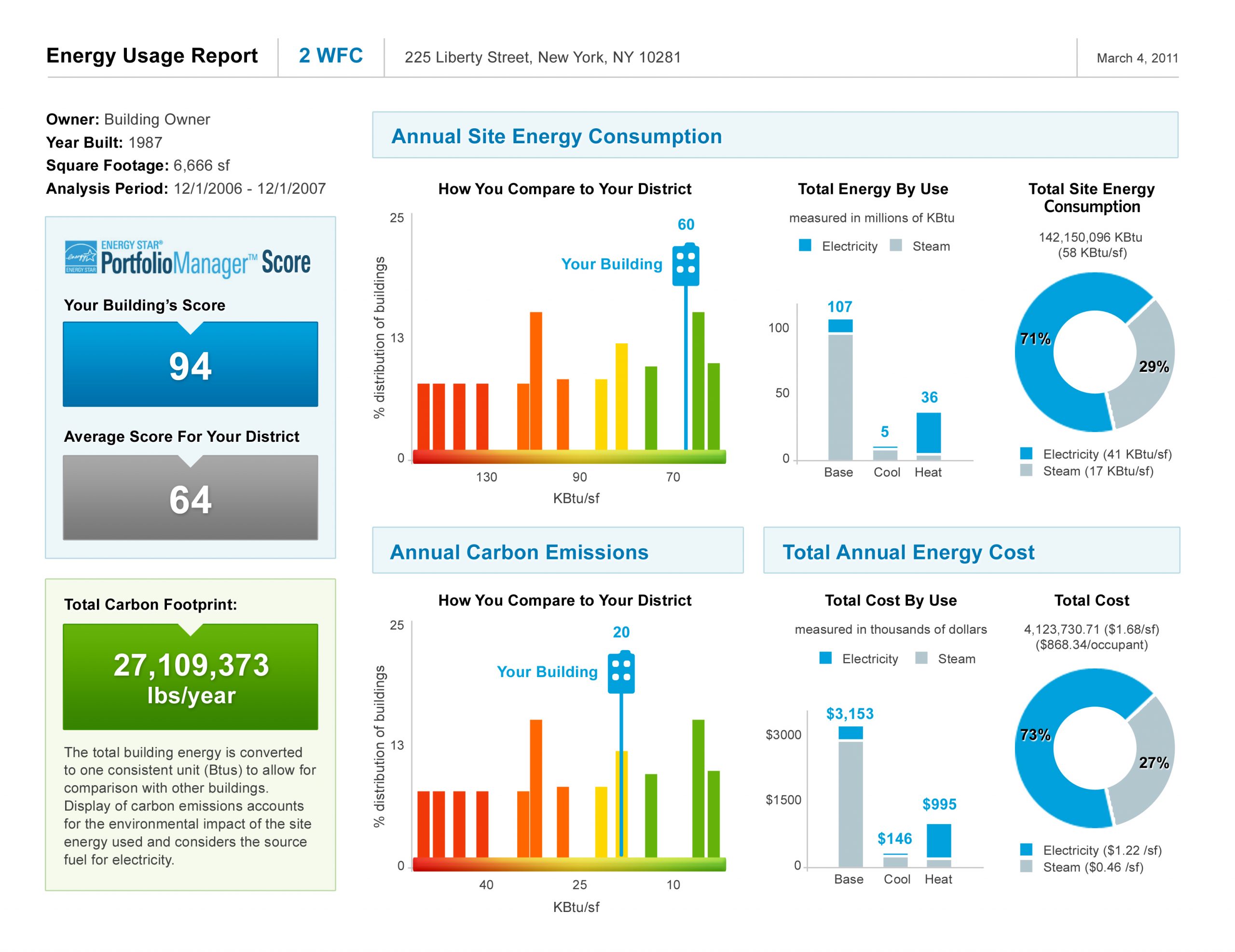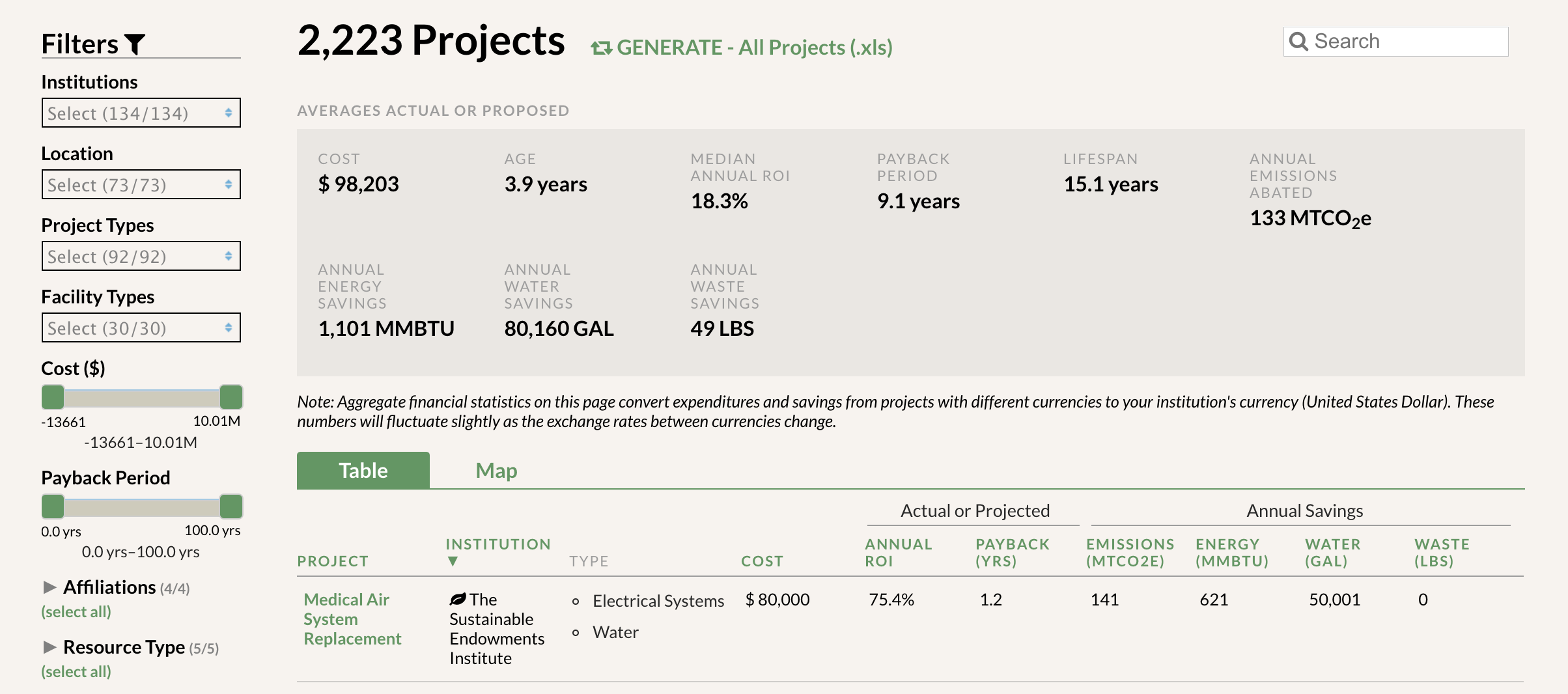When it comes to building energy use, a commonly repeated adage is: You can’t manage what you don’t measure. Building energy benchmarking is the process of measuring a building’s energy use and comparing performance to similar buildings. Benchmarking provides local governments with a simple pathway to examine and therefore manage their energy performance and associated costs and emissions.
Benchmarked energy data can be used to:
- Measure a building’s energy performance over time
- Establish energy reduction goals
- Identify opportunities for reduction in consumption and costs
- Gain recognition for high-performing buildings
- Comply with local and state energy reporting regulations
- Quantify energy and financial savings as a result of energy efficiency improvements
A US Environmental Protection Agency study of over 35,000 buildings found that buildings whose data was entered into ENERGY STAR Portfolio Manager, the EPA’s free benchmarking platform, averaged a 2.4% savings per year and 75% total savings over the course of the study. Yet detailed tracking and analysis of energy data is not common in many Texas city governments.
The ENERGY STAR Guidelines for Energy Management breaks the Assess Performance step of energy management into five steps:
Data Collection and Management
1. Gather and track data — Collect energy use information and document data over time.
Baselining and Benchmarking
2. Establish baselines — Determine the starting point from which to measure progress.
3. Benchmark — Compare the energy performance of your facilities to each other, peers and competitors, and over time to prioritize which facilities to focus on for improvements.
Analysis and Evaluation
4. Analyze — Understand your energy use patterns and trends.
5. Technical assessments and audits — Evaluate the operating performance of facility systems and equipment to determine improvement potential.
Gather and Track Data
Tracking a building’s energy use is a necessary first step toward reducing energy consumption and associated costs. You must determine what level of detail to include in your analysis. Determine if you will include all buildings in your portfolio or select facilities. To accurately benchmark your facilities’ performance against other similar facilities make sure to gather data on all energy sources including electricity, gas, chilled water, and steam. Collect energy data in appropriate energy units (kWh, mMBtu, etc.) as well as on a cost basis. Other facility details including building age, size, operating hours, and occupants are necessary for normalizing your building performance benchmarking platforms including ENERGY STAR Portfolio Manager.
Your retail energy provider or electric/gas utility can provide historic energy consumption and billing data. Customers can also often download their usage data directly from their providers’ website. In regions of Texas served by AEP Texas Central Company, AEP Texas North Company, CenterPoint Energy Houston Electric, LLC, Oncor Electric Delivery Company LLC, and Texas-New Mexico Power Company Smart Meter Texas is a valuable resource in gathering energy data necessary of benchmarking. The website provides secure access to daily, monthly, and 15-minute interval energy data to customers and authorized users. City staff as well as third party consultants can download energy data for benchmarking and more in depth analysis.
12 months of data is necessary to baseline a facility but it is a best practice to start with at 24 months of data for all energy sources. All energy units must be converted to a common unit, typically mMBtu (million British Thermal Units). Most energy data management and benchmarking platforms will automatically convert between energy units and are helpful to organize data and assist with long term tracking and reporting. Energy data can also be tracked on a simple spreadsheet. Regardless of the data management tool you select it should be easy to use, update, and maintain.
Energy Data Management Software
Although tracking energy data can still provide some insight into energy efficiency opportunities energy data management software can ease data management and provide additional layers analysis. The platforms featured below are a selection of energy data management tool types, there are countless tools and services available to assist with energy data management and analysis.
1. FREE: ENERGY STAR Portfolio Manager

*ENERGY STAR Portfolio Manager
The US Environmental Protection Agency’s ENERGY STAR Portfolio Manager is one of the best-known and commonly used energy data management tools for commercial and institutional buildings. Portfolio Manager helps you track and assess energy and water consumption within individual buildings as well as across your entire building portfolio. Portfolio Manager also tracks greenhouse gas emissions associated with your energy and water data. The platform normalizes energy data for weather so that an unusually cold or hot year does not throw off evaluation of energy performance. Building energy performance is benchmarked against internal portfolio performance as well as against a national dataset of buildings. For many commercial and institutional buildings, Portfolio Manager provides ENERGY STAR rating that score energy performance scale of 1–100 relative to similar buildings nationwide. Buildings that rate a 75 or higher may be eligible for ENERGY STAR certification.
2. PAID SERVICES: Energy Manager by Dude Solutions, EnergyCAP, and others

*Energy Manager by Dude Solutions
Paid services such as Energy Manager by Dude Solutions or EnergyCAP typically offer higher levels of functionality, customer service, and features than free platforms. Energy Manager for instance ties into a suite of tools available from Dude Solutions including software to manage workflow and assets, technology, capital forecasting, and other administrative and HR functions. Billing and account auditing features of the platforms can help identify inaccuracies in billing that utility provided data may not uncover. If your city is implementing an energy savings performance contract with an energy service company the ESCO may provide energy data tracking and management services as part of the contract. Typically third party services offer a tie into ENERGY STAR Portfolio Manager to enable seamless benchmarking to the national database and ENERGY STAR rating.
3. SUSTAINABILITY FOCUSED: Environmental Sustainability Management – CSRware, GRITS – Sustainable Endowments Institute

*GRITS by Sustainable Endowments Institute
Other data management platforms have emerged to specifically serve organizations with sustainability goals and targets. CSRware’s Environmental Sustainability Management platform offers data management functionality specifically oriented for sustainability reporting. GRITS supports project evaluation, and helps institutions analyze, track, and share the energy, financial, and carbon-saving impacts of their sustainability projects. These platforms may be best suited for supplementing a tool specifically design for energy data management and analysis.
Baselining and Benchmarking
Baselining and benchmarking is the foundation of energy management yet sometimes these two terms are mistakenly used interchangeably. For these purposes, let us use these definitions:
- Baselining (Where am I today?) Collecting and analyzing energy performance for a set period of time (usually a 12 month period) to establish a starting point (baseline) from which to compare energy performance change over time.
- Benchmarking (How do I compare to others?) Benchmarking is the practice of comparing the measured performance of a facility to itself, its peers, or established norms, with the goal of informing and motivating performance improvement.
A facility’s baseline is often the last 12 months of energy consumption data though a baseline may be an average of several years of data. The baseline data set should be as complete and relevant as possible. For instance, do not use a baseline year where the facility’s occupancy or operation changed substantially. Identify an evaluation metric that can be used to compare performance year-over-year. Energy use intensity, typically expressed in kBtu per square foot of floor area per year, is a common metric used to evaluate energy performance overtime and benchmark performance. Record the facility’s baseline for reference and share with key stakeholders such as facility managers and decision makers.
Benchmarking is the key step in determining if a facility may be a candidate for energy management or energy efficiency upgrades. A facility can be benchmarked to other buildings in the city’s building portfolio to see which facilities are using the most energy or is costing the most to operate. Yet comparing the EUI of you city hall building to your water treatment plant will not provide very valuable insight since the buildings serve very different purposes and use energy differently. It can be more helpful to compare how your City Hall’s energy use compares to other similar government office buildings. ENERGY STAR Portfolio Manager and other energy management platforms compare your building’s energy performance to large data sets of comparable buildings. Ultimately comparing your building’s performance to previous years of performance to determine impact of energy efficiency efforts is the most common version of benchmarking and may be the most valuable for your organization.
Further Reading
Learn more about Texas cities that encourage benchmarking of commercial, multifamily, and residential buildings through benchmarking ordinances and read a case study about Houston’s benchmarking program in our City Efficiency Toolkit.